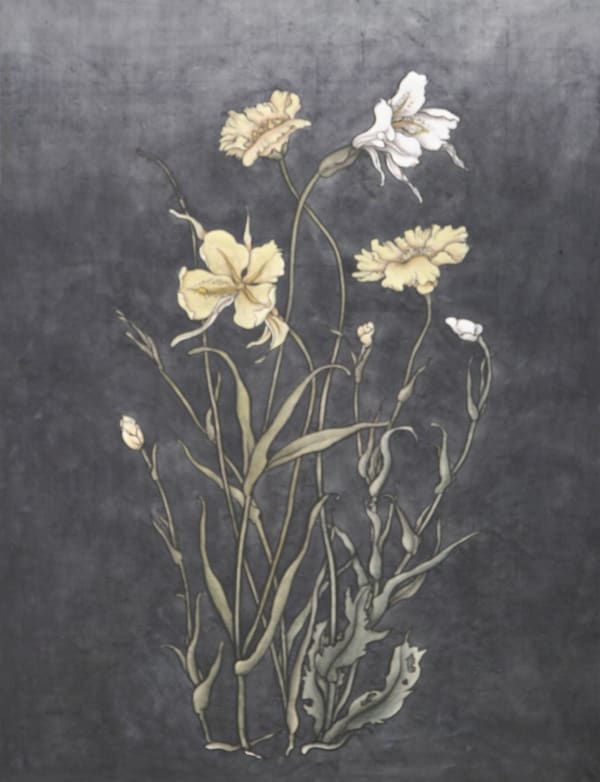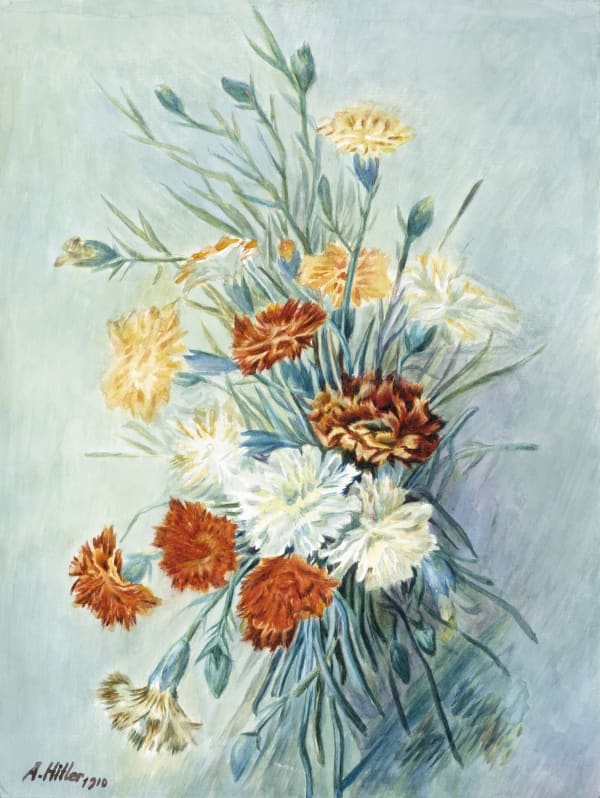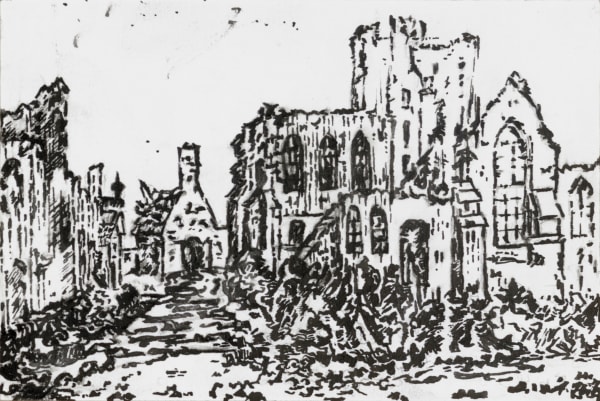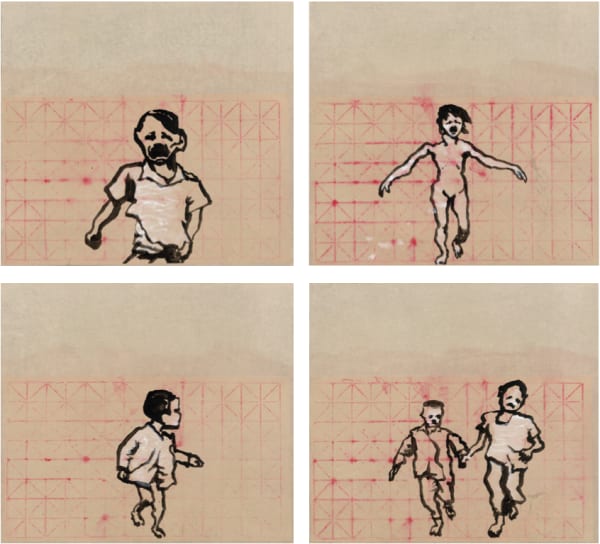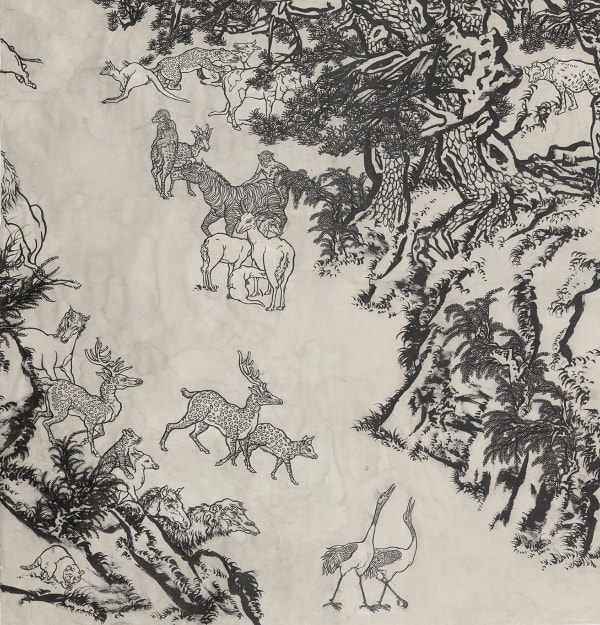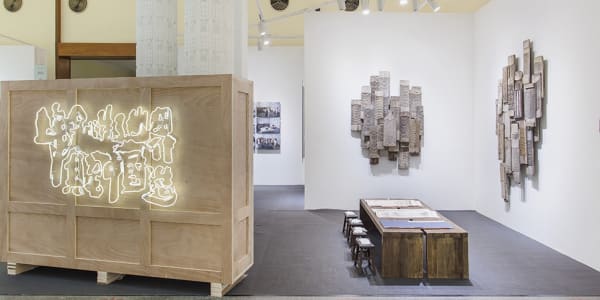还是花鸟 山水画: 杨诘苍
墨斋画廊《还是花鸟 山水画》将展出杨诘苍的一系列既不安定又独具美感的作品。权利、暴力与恐惧是杨诘苍绘画的核心;同时,艺术家也重视形式的超越、自我的升华以及博爱的表现。杨诘苍引人入胜的精湛技巧,让人紧张甚至恐惧,亦使人感到极度缺乏人性的荒谬与超然。
杨诘苍的艺术实践追求极致和参与,这使其在中国传统水墨画中独树一帜。十八世纪末十九世纪初,西班牙画家戈雅(1746-1828)创作了《战争灾难》和《狂想曲》系列版画。至此,欧洲艺术家便习惯于将评论社会愚事和灾难视为己任。相反,中国的水墨艺术家始终坚守儒、释、道的信仰,作品与之相应地体现出诗书画相结合的特色。作为当代艺术家,杨诘苍拒绝了中国传统身份而选择了社会行动者的角色。
此前,杨诘苍将唐、宋和元代佛教壁画中浓丽的用线与工笔、花鸟画法相结合,创造出描绘战争、屠杀、恐惧、毁灭、财富和权力的画面。其中最广为人知的是曾在2003年威尼斯双年展,及2013-2014年“古法今用:纽约大都会博物馆当代水墨艺术大展”中展出的《会叫的风景》系列。本次画展展出的作品都是艺术家的最新之作。作品沿袭了之前的画风。《还是花鸟画》临摹了希特勒的花卉作品。《芥子园》之一隐喻着死亡的风景。《紫光土》则来源于《十一日谈》系列作品,描述了动物间跨越物种的情爱。
杨诘苍在笔墨的表现性上同样才华横溢。他在作品中运用了写意的技法,这与传统中文学,如诗歌中的比兴手法有异曲同工之妙。这次展览中,杨诘苍用这种方式创作了各类作品,有些作品是尖锐的片段,有些是战时的个人图象,还有些是艺术家本人的训告,如《不许动作》、《什么都很重要》及《鞭》。主要作品《战后1914-2014》描画了一位丢盔卸甲的落魄士兵和他的战马,背景是消失在远方的遭受炸毁的城市。一对雕塑作品《花少年》和《铁拐李》展现了一个青年满怀希望,又遭到严重残害的不同状态。
今年恰逢第一次世界大战开始一百周年,正如作品《战后1914-2014》名字所强调的,我们可以把整个展览看成是对避免大规模灾难和暴力的警示,自然本身是中立的,希特勒所画的花卉也是花卉,反映人类愚行的风景依然是风景。
早在学生时代,就读广州美术学院的杨诘苍就秉承了“异己分子”的立场,这与文革期间青年造反派的风气息息相关。毕业之后,杨诘苍试图退出艺术界,转而参禅学道。这段经历促成他之后求简的画风。从1988年移居欧洲至今,杨诘苍仍频频往返于巴黎和海德堡。1989年,他参加了中国美术馆举办的“中国前卫艺术大展”,并在巴黎蓬皮杜艺术中心参与了“大地魔术师”的展览的现场制作。之后,他的作品曾多次参加国际重要展览。仅以近五年为例,其中包括“以退为进”(外滩美术馆,上海,2014年)、“古法今用:纽约大都会博物馆当代水墨艺术大展”(大都会艺术博物馆,纽约,2013年-2014年)、“原道”(香港艺术馆,香港,2013年)、“上海双年展:重新发电”(上海当代艺术博物馆,上海,2012年)、“世界属于你”(格拉斯宫,弗朗索瓦·皮诺基金会,威尼斯,2011年)、“Hareng Saur”(比利时、根特美术馆,2010年)、“里昂双年展”(里昂,2009年)、“谁会惧怕艺术家?皮诺艺术收藏展”(迪纳尔博物馆,迪纳尔,2009年)。
过去五年中,杨诘苍还在各大美术馆举办个展,如:深圳华·美术馆(2012年)、雷恩当代艺术中心(2011年)、 The Associazione Culturale Cantiere d’Arte Alberto Moretti-Galleria Schema (2009年)。今年,他还将在德国汉堡Phoenixhalle举办个展“杨诘苍:我常做坏事”。
收藏杨诘苍作品的公共机构包括香港艺术馆、香港大学美术博物馆、深圳画院、广州美术馆、美国斯坦福大学坎托艺术中心、伯克利艺术博物馆、福冈市美术馆、汉堡工艺美术馆、墨西哥城现代艺术文化中心、华盛顿世界银行、洛克菲勒基金会、法国文化部。私人收藏包括弗朗索瓦·皮诺基金会、瑞士尤伦斯基金会、台湾国家文化艺术基金会及台湾诚品画廊。
林似竹博士(Britta Erickson)是墨斋的艺术总监和本次展览的策展人,现居于美国加利福尼亚帕洛奥图。林博士作为独立学者与策展人曾多次为华盛顿赛克勒美术馆(2001-2002)和斯坦福大学坎特视觉艺术中心(2005)策划重要展览。2007年,她参与策划了以水墨艺术为主题的成都双年展。此后,又作为特约策展人筹划了2010年在旧金山亚洲艺术博物馆举办的“上海:城市中的艺术”展。林女士还是香港“水墨会”和北京“三影堂摄影艺术中心”顾问委员会成员,以及《典藏国际版文选》和《亚太艺术杂志》编委成员。2006年她荣获福布莱特奖学金,以在北京调研中国当代艺术市场。林博士在斯坦福大学获得中国艺术史博士学位。
杨诘苍是林似竹博士出品的纪录片《墨咏》中十位专题艺术家之一,艺术家的工作和生活也将成为画展之后学术出版的主题。该出版物由林似竹博士担任主编,并定于展览闭幕六个月后出版,由艺术出版社D.A.P.在美国发行。
-
 Yang Jiechang 杨诘苍, These are still Flowers 1913-2013 No. 1 还是花鸟画1913-2013 1号, 2013
Yang Jiechang 杨诘苍, These are still Flowers 1913-2013 No. 1 还是花鸟画1913-2013 1号, 2013 -
 Yang Jiechang 杨诘苍, These are still Flowers 1913-2013 No. 2 还是花鸟画1913-2013 2号, 2013
Yang Jiechang 杨诘苍, These are still Flowers 1913-2013 No. 2 还是花鸟画1913-2013 2号, 2013 -
 Yang Jiechang 杨诘苍, These are still Flowers 1913-2013 No. 3 还是花鸟画1913-2013 3号, 2013
Yang Jiechang 杨诘苍, These are still Flowers 1913-2013 No. 3 还是花鸟画1913-2013 3号, 2013 -
 Yang Jiechang 杨诘苍, These are still Flowers 1913-2013 No. 4 还是花鸟画1913-2013 4号, 2013
Yang Jiechang 杨诘苍, These are still Flowers 1913-2013 No. 4 还是花鸟画1913-2013 4号, 2013 -
 Yang Jiechang 杨诘苍, These are still Flowers 1913-2013 No. 5 还是花鸟画1913-2013 5号, 2013
Yang Jiechang 杨诘苍, These are still Flowers 1913-2013 No. 5 还是花鸟画1913-2013 5号, 2013 -
 Yang Jiechang 杨诘苍, These are still Flowers 1913-2013 No. 6 还是花鸟画1913-2013 6号, 2013
Yang Jiechang 杨诘苍, These are still Flowers 1913-2013 No. 6 还是花鸟画1913-2013 6号, 2013 -
 Yang Jiechang 杨诘苍, These are still Flowers 1913-2013 No. 7 还是花鸟画1913-2013 7号, 2013
Yang Jiechang 杨诘苍, These are still Flowers 1913-2013 No. 7 还是花鸟画1913-2013 7号, 2013 -
 Yang Jiechang 杨诘苍, These are still Flowers 1913-2013 No. 8 还是花鸟画1913-2013 8号, 2013
Yang Jiechang 杨诘苍, These are still Flowers 1913-2013 No. 8 还是花鸟画1913-2013 8号, 2013 -
 Yang Jiechang 杨诘苍, These are still Flowers 1913-2013 No. 9 还是花鸟画1913-2013 9号, 2013
Yang Jiechang 杨诘苍, These are still Flowers 1913-2013 No. 9 还是花鸟画1913-2013 9号, 2013 -
 Yang Jiechang 杨诘苍, These are still Flowers 1913-2013 No. 10 还是花鸟画1913-2013 10号, 2013
Yang Jiechang 杨诘苍, These are still Flowers 1913-2013 No. 10 还是花鸟画1913-2013 10号, 2013 -
 Yang Jiechang 杨诘苍, These are still Flowers 1913-2013 No. 11 还是花鸟画1913-2013 11号, 2013
Yang Jiechang 杨诘苍, These are still Flowers 1913-2013 No. 11 还是花鸟画1913-2013 11号, 2013 -
 Yang Jiechang 杨诘苍, These are still Flowers 1913-2013 No. 12 还是花鸟画1913-2013 12号, 2013
Yang Jiechang 杨诘苍, These are still Flowers 1913-2013 No. 12 还是花鸟画1913-2013 12号, 2013 -
 Yang Jiechang 杨诘苍, These are still Flowers 1913-2013 No. 13 还是花鸟画1913-2013 13号, 2013
Yang Jiechang 杨诘苍, These are still Flowers 1913-2013 No. 13 还是花鸟画1913-2013 13号, 2013 -
 Yang Jiechang 杨诘苍, These are still Flowers 1913-2013 No. 14 还是花鸟画1913-2013 14号, 2013
Yang Jiechang 杨诘苍, These are still Flowers 1913-2013 No. 14 还是花鸟画1913-2013 14号, 2013 -
 Yang Jiechang 杨诘苍, These are still Flowers 1913-2013 No. 15 还是花鸟画1913-2013 15号, 2013
Yang Jiechang 杨诘苍, These are still Flowers 1913-2013 No. 15 还是花鸟画1913-2013 15号, 2013 -
 Yang Jiechang 杨诘苍, These are still Flowers 1913-2013 No. 17 还是花鸟画1913-2013 17号, 2013
Yang Jiechang 杨诘苍, These are still Flowers 1913-2013 No. 17 还是花鸟画1913-2013 17号, 2013 -
 Yang Jiechang 杨诘苍, Black and White Mustard Seed Garden (Tale of the 11th Day series) 十一日谈系列:白描芥子园, 2009-2014
Yang Jiechang 杨诘苍, Black and White Mustard Seed Garden (Tale of the 11th Day series) 十一日谈系列:白描芥子园, 2009-2014 -
 Yang Jiechang 杨诘苍, Mustard Seed Garden No. 1 芥子园 1号, 2010
Yang Jiechang 杨诘苍, Mustard Seed Garden No. 1 芥子园 1号, 2010 -
 Yang Jiechang 杨詰苍, Mustard Seed Garden No. 2 芥子园 2号, 2010
Yang Jiechang 杨詰苍, Mustard Seed Garden No. 2 芥子园 2号, 2010 -
 Yang Jiechang 杨诘苍, Violet Land (Tale of the 11th Day series) 十一日谈系列:紫光土, 2009-2013
Yang Jiechang 杨诘苍, Violet Land (Tale of the 11th Day series) 十一日谈系列:紫光土, 2009-2013 -
 Yang Jiechang 杨诘苍, After the Battle 1914-2014 战后 1914-2014, 2014
Yang Jiechang 杨诘苍, After the Battle 1914-2014 战后 1914-2014, 2014 -
 Yang Jiechang 杨诘苍, After the Battle 1914-2014 No. 2 战后 1914-2014 2号, 2014
Yang Jiechang 杨诘苍, After the Battle 1914-2014 No. 2 战后 1914-2014 2号, 2014 -
 Yang Jiechang 杨诘苍, After the Battle 1914-2014 No. 3 战后 1914-2014 3号, 2014
Yang Jiechang 杨诘苍, After the Battle 1914-2014 No. 3 战后 1914-2014 3号, 2014 -
 Yang Jiechang 杨诘苍, After the Battle 1914-2014 No. 4 战后 1914-2014 4号, 2014
Yang Jiechang 杨诘苍, After the Battle 1914-2014 No. 4 战后 1914-2014 4号, 2014 -
 Yang Jiechang 杨诘苍, After the Battle 1914-2014 Nos. 5 and 6 战后 1914-2014 5,6号, 2014
Yang Jiechang 杨诘苍, After the Battle 1914-2014 Nos. 5 and 6 战后 1914-2014 5,6号, 2014 -
 Yang Jiechang 杨诘苍, Heavenly Horse 天马, 2014
Yang Jiechang 杨诘苍, Heavenly Horse 天马, 2014 -
 Yang Jiechang 杨诘苍, Königssee 国王湖, 2013
Yang Jiechang 杨诘苍, Königssee 国王湖, 2013 -
 Yang Jiechang 杨诘苍, Light under the Water 1914-2014 湖光1914-2014, 2014
Yang Jiechang 杨诘苍, Light under the Water 1914-2014 湖光1914-2014, 2014 -
 Yang Jiechang 杨诘苍, These are still Landscapes 1904-2014 No. 1 还是山水画1904-2014 1号, 2014
Yang Jiechang 杨诘苍, These are still Landscapes 1904-2014 No. 1 还是山水画1904-2014 1号, 2014 -
 Yang Jiechang 杨诘苍, These are still Landscapes 1904-2014 No. 2 还是山水画1904-2014 2号, 2014
Yang Jiechang 杨诘苍, These are still Landscapes 1904-2014 No. 2 还是山水画1904-2014 2号, 2014 -
 Yang Jiechang 杨诘苍, These are still Landscapes 1904-2014 No. 3 还是山水画1904-2014 3号, 2014
Yang Jiechang 杨诘苍, These are still Landscapes 1904-2014 No. 3 还是山水画1904-2014 3号, 2014 -
 Yang Jiechang 杨诘苍, These are still Landscapes 1911-2013 No. 6 还是山水画1911-2013 6号, 2013
Yang Jiechang 杨诘苍, These are still Landscapes 1911-2013 No. 6 还是山水画1911-2013 6号, 2013 -
 Yang Jiechang 杨诘苍, These are still Landscapes 1911-2013 No. 7 还是山水画1911-2013 7号, 2013
Yang Jiechang 杨诘苍, These are still Landscapes 1911-2013 No. 7 还是山水画1911-2013 7号, 2013 -
 Yang Jiechang 杨诘苍, These are still Landscapes 1907-2013 No. 8 还是山水画1907-2013 8号, 2013
Yang Jiechang 杨诘苍, These are still Landscapes 1907-2013 No. 8 还是山水画1907-2013 8号, 2013 -
 Yang Jiechang 杨诘苍, These are still Landscapes 1911-2011 No. 9 还是山水画1901-2011 9号, 2011
Yang Jiechang 杨诘苍, These are still Landscapes 1911-2011 No. 9 还是山水画1901-2011 9号, 2011 -
 Yang Jiechang 杨诘苍, These are still Landscapes 1914-2014 No. 11 还是山水画1914-2014 11号, 2014
Yang Jiechang 杨诘苍, These are still Landscapes 1914-2014 No. 11 还是山水画1914-2014 11号, 2014 -
 Yang Jiechang 杨诘苍, These are still Landscapes 1907-2013 No. 12 还是山水画1907-2013 12号, 2013
Yang Jiechang 杨诘苍, These are still Landscapes 1907-2013 No. 12 还是山水画1907-2013 12号, 2013 -
 Yang Jiechang 杨诘苍, These are still Landscapes 1907-2013 No. 13 还是山水画1907-2013 13号, 2013
Yang Jiechang 杨诘苍, These are still Landscapes 1907-2013 No. 13 还是山水画1907-2013 13号, 2013 -
 Yang Jiechang 杨诘苍, Children Running 1, 2, 3, 4 跑吧 1, 2, 3, 4, 2014
Yang Jiechang 杨诘苍, Children Running 1, 2, 3, 4 跑吧 1, 2, 3, 4, 2014 -
 Yang Jiechang 杨诘苍, Possible 可能, 2007
Yang Jiechang 杨诘苍, Possible 可能, 2007 -
 Yang Jiechang 杨诘苍, Everything Is Important 什么都很重要, 2006
Yang Jiechang 杨诘苍, Everything Is Important 什么都很重要, 2006 -
 Yang Jiechang 杨诘苍, Do not Move 不许动作, 2014
Yang Jiechang 杨诘苍, Do not Move 不许动作, 2014 -
 Yang Jiechang 杨诘苍, Young Man with Flowers 1924-2014 No. 1 花少年 1924-2014 1号, 2014
Yang Jiechang 杨诘苍, Young Man with Flowers 1924-2014 No. 1 花少年 1924-2014 1号, 2014 -
 Yang Jiechang 杨诘苍, Young Man with Flowers 1924-2014 No. 2 花少年 1924-2014 2号, 2014
Yang Jiechang 杨诘苍, Young Man with Flowers 1924-2014 No. 2 花少年 1924-2014 2号, 2014 -
 Yang Jiechang 杨诘苍, Tieguai Li 1924-2014 No. 1 铁拐李 1924-2014 1号, 2014
Yang Jiechang 杨诘苍, Tieguai Li 1924-2014 No. 1 铁拐李 1924-2014 1号, 2014
This Is Still Landscape Painting features new works by artist Yang Jiechang (b. 1956 in Foshan, Guangdong province, China). With this exhibition, Yang presents his audience with a range of paintings that are both disturbing and beautiful. Power, violence and terror are central concerns in Yang’s art and yet so are transcendence of form, sublimation of self and universal love. When Yang deploys seductively masterful technique in service of psychologically disturbing or even horrifying imagery, our experience approaches the sublime — a realization of the inhuman that is both monstrous and transcendent.
In his pursuit of both the sublime and the engaged, Yang’s artistic practice is perhaps unique in the history of traditional Chinese brush and ink painting. Since the late eighteenth and early nineteenth century Disasters of War and Los Caprichos series by Goya (1746–1828), European artists have taken it as their role to comment on society’s follies and disasters. Chinese brush artists, by contrast, continued to embrace the Confucian, Daoist and Buddhist moral norms long-established for the fine arts of poetry, calligraphy and brush painting. As a contemporary artist, Yang Jiechang rejects this traditional norm and embraces the role of social actor.
In the past, Yang Jiechang has combined the intense mineral pigments and brushwork of Tang, Song and Yuan dynasty Buddhist mural paintings with the fine line (工笔 gongbi) brush technique associated with paintings of birds and flowers, to paint images of war, massacre, terror, holocaust, wealth and power. His most widely known works in this mode are from his Crying Landscape series exhibited at the 2003 Venice Biennale and featured in the 2013–2014 Metropolitan Museum’s Ink Art: Past as Present in Contemporary China exhibition. This Is Still Landscape Painting features Yang’s most recent works in this mode, These Are Still Flowers (flower paintings based on paintings by Hitler), Mustard Seed Garden 1 (landscapes with hidden images of death) and Violet Land (from the 11th Day Series, depicting a variety of animal species engaged in inter-species expressions of love).
Yang Jiechang is equally talented when working in expressive calligraphic ink brushwork. In this mode of painting Yang cites the freehand style of painting (写意 xieyi, literally meaning ‘writing of ideas’) traditionally associated with a literary or poetic treatment of morally positive subject matter. For This Is Still Landscape Painting he has created a variety of works in this manner, with some depicting poignant vignettes, iconic wartime images of individuals, and others displaying the artist’s exhortations, for example “Do Not Move,” “Everything Is Important,” and “Whip.” The major piece After the Battle 1914-2014 portrays a succinctly rendered fallen soldier and his horse overlaid against a background bombed-out city that fades from view. Finally, a pair of sculptures, Young Man with Flowers 1924-2014 1 and Tieguai Li 1924-2014 1 shows the state of an individual, initially hopefully holding flowers, and later with devastating injuries.
As underscored by the title of After the Battle 1914-2014, this year marks the hundredth anniversary of the start of the First World War. Perhaps we can see the exhibition as a whole as a call to avoid disastrous large-scale violence. Nature itself is neutral — flowers are still flowers even if painted by Hitler, and the landscape is still a landscape, even when it is witness to the folly of humankind.
Already in his student days at the Guangzhou Academy of Fine Arts, Yang Jiechang had adopted the position of provocateur, a position reinforced by his experiences in China’s Cultural Revolution when youth were encouraged to rebel. Following graduation he tried to withdraw from art to study with Buddhist and Daoist masters. This led him to search for simplicity when he returned to painting. In 1988 he moved to Europe, where he has remained, living between Paris and a village near Heidelberg. In 1989 he participated in both the seminal Contemporary Chinese Art exhibition at the National Art Museum in Beijing and the equally paradigm-changing exhibition Les magiciens de la terre at the Centre Georges Pompidou where he created his artworks on the scene. Since then his work has been included in numerous major international exhibitions, including Advance through Retreat (Rockbund Art Museum, Shanghai, 2014), Ink Art: Past as Present in Contemporary China (Metropolitan Museum, New York, 2013-2014), Yuandao (Hong Kong Museum of Art, Hong Kong, 2013), Reactivation — Shanghai Biennale (Shanghai, 2012), The World Belongs to You (Palazzo Grassi, Fondation F. Pinault, Venice, 2011), Hareng Saur: Ensor et contemparain (MSK and S.M.A.K., Ghent, Belgium, 2010), Lyon Biennial (Lyon, 2009), Qui a peur des artistes ? Une sélection d’œuvres de la Fondation François Pinault (Musée de Dinard, Dinard, 2009), all from the last five years.
Also during the last five years his work has been the subject of solo exhibitions at the OCT Art & Design Gallery, Shenzhen (2012), Centre d’art contemporain, Rennes (2011), and the Associazione Culturale Cantiere d’Arte Alberto Moretti-Galleria Schema, Prato (2009), among others, and later this year Yang Jiechang — I often do bad things will open at the Phoenixhalle in Hamburg.
Public institutions that have collected Yang Jiechang’s work include the Hong Kong Museum of Art; Hong Kong University Art Museum; Shenzhen Fine Art Institute; Guangzhou Museum of Art; Cantor Art Centre, Stanford University; Berkeley Art Museum; Fukuoka Art Museum; Museum for Arts and Crafts, Hamburg; Centro Cultural Arte Contemporaneo, Mexico City; The World Bank, Washington, D.C.; Rockefeller Foundation; French Ministry of Culture. Such private collections as the François Pinault Foundation; Ullens Foundation, Switzerland; Yageo Art Foundation, Taiwan; and Eslite Inc., Taiwan also include his work.
Dr. Britta Erickson, Ink Studio’s Artistic Director and curator of This Is Still Landscape Painting, is an independent scholar and curator living in Palo Alto, California. She has curated major exhibitions at the Arthur M. Sackler Gallery, Washington, D.C. (2001–2002) and the Cantor Center for Visual Arts, Stanford (2005). In 2007 she co-curated the Chengdu Biennial, which focused on ink art, and in 2010 she was a contributing curator for Shanghai: Art of the City (Asian Art Museum, San Francisco). Ms. Erickson is on the advisory boards of the Ink Society (Hong Kong) and Three Shadows Photography Art Centre (Beijing), as well as the editorial boards of Yishu: Journal of Contemporary Chinese Art and ART AsiaPacific. In 2006 she was awarded a Fulbright Fellowship to conduct research in Beijing on the Chinese contemporary art market. Dr. Erickson received her Ph.D. in Chinese Art History from Stanford University.
Yang Jiechang is one of ten artists featured in the documentary film series, The Enduring Passion for Ink, produced by Britta Erickson, and his work and life is the subject of a forthcoming scholarly publication, edited by Dr. Erickson. The publication will appear approximately six months after the closure of the exhibition and will be distributed in the USA by D.A.P.








